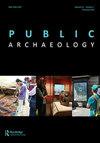Ethical Considerations Associated with the Display and Analysis of Juvenile Mummies from the Capuchin Catacombs of Palermo, Sicily
IF 0.9
4区 历史学
0 ARCHAEOLOGY
引用次数: 2
Abstract
The Capuchin Catacombs of Palermo (Sicily) are a unique and culturally rich site utilized from the late sixteenth to mid-twentieth century. The Catacombs are home to the largest collection (n = 1,284) of partly or completely mummified remains in Europe, and the largest assemblage of juvenile mummies (n = 163) in Sicily. As a result, the site attracts thousands of visitors every year. This raises a number of ethical concerns in terms of the preservation, display, and scientific analysis of these mummies. This article will investigate the ethical challenges associated with the display and analysis of juvenile mummified individuals in the Capuchin Catacombs. Initially, ethical issues that arise when displaying mummified children at a visitor site will be explored. Subsequently, the value of adopting non-invasive techniques to answer highly focused, ethically grounded research questions will be addressed. Furthermore, this article will demonstrate the importance of transparent, open dialogue with religious groups and cultural heritage bodies in the study of juvenile mummies. Recommendations for best practice are provided at the end of this paper. These guidelines aim to ensure that juvenile mummies are displayed and analysed appropriately, whilst simultaneously respecting the beliefs and wishes of the living and deceased.与西西里岛巴勒莫卷尾猴地下墓穴中少年木乃伊的展示和分析相关的伦理考虑
帕勒莫(西西里岛)的Capuchin地下墓穴是一个独特而文化丰富的遗址,从16世纪末到20世纪中期被利用。这些地下墓穴拥有欧洲最大的部分或完全木乃伊化的遗骸收藏(1284具),也是西西里岛最大的青少年木乃伊收藏(163具)。因此,该网站每年吸引成千上万的游客。这引发了对这些木乃伊的保存、展示和科学分析方面的一些伦理问题。本文将探讨与卷尾猴地下墓穴中青少年木乃伊的展示和分析相关的伦理挑战。首先,将探讨在游客景点展示儿童木乃伊时出现的道德问题。随后,采用非侵入性技术来回答高度集中的、基于伦理的研究问题的价值将得到解决。此外,本文将展示在研究青少年木乃伊时,与宗教团体和文化遗产机构进行透明、公开对话的重要性。本文最后提供了最佳实践的建议。这些指导方针旨在确保青少年木乃伊得到适当的展示和分析,同时尊重生者和死者的信仰和愿望。
本文章由计算机程序翻译,如有差异,请以英文原文为准。
求助全文
约1分钟内获得全文
求助全文

 求助内容:
求助内容: 应助结果提醒方式:
应助结果提醒方式:


